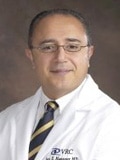
Macular Degeneration The Growing Epidemic
By Sam E. Mansour, MD, MSc, FRCS(C), FACS
Virginia Retina Center
.
http://virginiaretina.com/
More Vision & Eye Care Articles
Macular Degeneration The Growing Epidemic
As the leading cause of blindness for those aged 55 and older in this country, age-related macular degeneration (ARMD) affects more than 15 million Americans. It is the principle cause of registered legal blindness in people over 65 years old in the United States, Europe, Australia, and Japan. In this country, there are two million new cases of ARMD per year.
The disease affects the macular region of the retina inside the eye. The macula is the central region of the retina where over 80% of the functional vision occurs and is critical for simple tasks as reading and driving.
Traditionally ARMD is divided into two types; more common and initially less debilitating is “atro-phic”ARMD which is often called “dry”. Dry ARMD affects 85 to 90% of all patients with ARMD. By contrast, exudative or “wet” ARMD is most responsible for severe visual loss in those afflicted with the more rigorous form of the disease.
The earliest clinical sign of ARMD is the presence of gold colored deposits in the macula, called drusen,which begin to slowly distort and blur vision. The visual distortion can make straight lines, such as a doorway, appear wavy or bent. With progression, abnormal new blood vessels begin to grow underneath and within the retina where they bleed and leak fluid causing immediate blind spots in the vision. This leads to the formation of thick scars destroying the macula, characteristic of wet ARMD.
Certain lifestyle and dietary factors have been identified in recent years that can alter the course of ARMD. Smoking, obesity, high total fat intake or high content of omega-6 fatty acids intake can increase the risk of ARMD. With regard to diet, increasing the consumption of foods rich in carotenoids may decrease the risk of disease progression as well as having a higher intake of fish, nuts, fruits or vegetables that are yellow or orange in color seem to reduce the risk of ARMD progression.
ARMD also appears to have a strong genetic component. We know from previous studies that children and the relatives of patients with advanced ARMD have a 50% chance of developing the disease in contrast to 12% of the normal population.
Although there is currently no definitive treatment for ARMD, therapy can be broadly divided into three categories and aimed at patients with the wet form of the disease to slow the degenerative process. To begin with, there are laser therapies involving selective destruction of the abnormal blood vessels. The second category consists of drugs that inhibit the growth of blood vessels by direct injections into the eye, such as Macugen, Lucentis and Avastin. Lastly, the least commonly employed treatment involves surgery.
While currently there is no cure for ARMD, it is still very important for all middle-aged and senior persons to use simple daily self-screening methods such as the Amsler Grid and complete an eye examination every two years. While exciting developments hold out hope for this devastating condition, early diagnosis still remains critical for any successful treatment of ARMD.
Other Articles You May Find of Interest...
- Dry Eye Relief Is In Sight With Optilight
- iDesign Advanced WaveScan Studio
- Norcross Vision Innovators: Glaucoma and Cataract Solutions
- Exploring the Benefits Of Intense Pulsed Light (IPL) For Ocular Surface Health
- Lose Years Off Your Face In Just One Hour
- How to Find a Great Online Shop Offering Same Day Glasses Shipping: Your Quick Guide
- March Is Workplace Eye Wellness Month

















